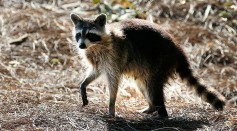canine
Sabertooth That Roamed South America 3 Million Years Ago Had Large Canine, Pushing Its Eyes to the Sides of the Head [Study]

Canines Discovered to Grieve When Another Pet Dog Dies in Same Household

Genetic Mutation From Ancient Wolves 53,000 Years Ago Made Some Dog Breeds to Have Smaller Body

Man's Best Friend Cant Resist Human Allure vs Wolf Puppies, According to Study

Over 50 Canines Tests Positive with Unexpected Flu Outbreak at Rescue Center

Raccoons in Arlington Test Positive for Canine Distemper

FDA Continues Investigation of Link Between Fatal Heart Ailment and Diet in Dogs

Dogs Can Help Reduce Asthma, Among MANY Other Things

Scientists Train Canines to Detect Covid-19 Through Body Odor: Watch How
New Strain of Canine Distemper in Wild Animals in New Hampshire and Vermont Discovered
Dogs Sniff Out Cancer With 95% Accuracy, According To Study
You Can Teach an Old Dog New Tricks, But You Can’t Clean Up Their Drinking Habits
Grand Canyon Wolf—Female Offers New Hope of Grand Canyon Pack’s Return
Most Popular

How Technology Is Changing the Real Estate Industry?

Study Reveals High Turnover in Scientific Research Careers: What This Means for Future Scientists

How a Plant-Based Diet Can Protect Against Breast Cancer: Insights from Nutrition Research

Practical Steps to Future-Proof Your Money to Create Financial Security






